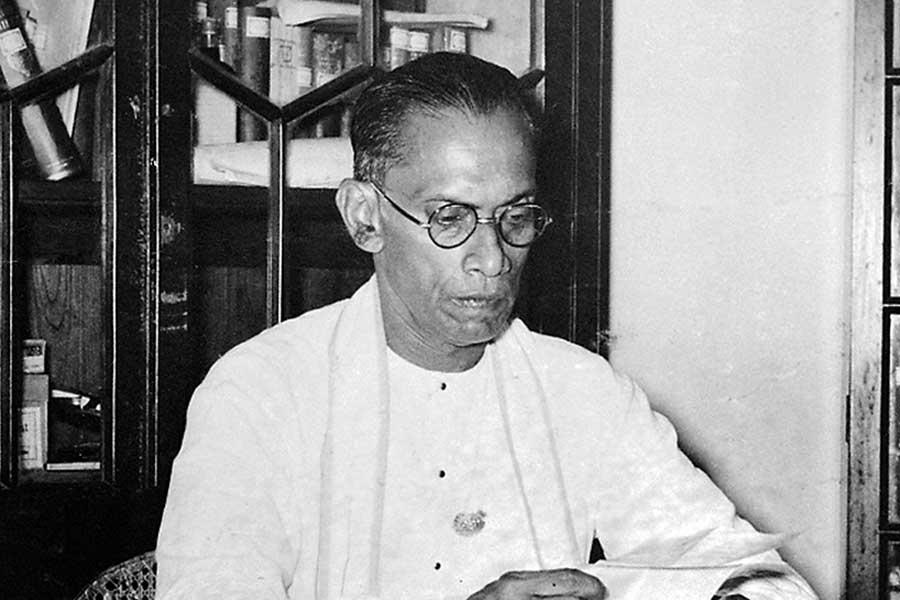Reply To:
Name - Reply Comment

It was around 9.45; the morning sun shone brightly in Colombo on September 25, 1959. Residents in the vicinity focused their attention in the direction of ‘Tintagel’ at 65, Rosemead Place, in the heart of the most fashionable residential quarter of the city known as Cinnamon Gardens [CG], from where the report of a few rounds of firearm was heard.
focused their attention in the direction of ‘Tintagel’ at 65, Rosemead Place, in the heart of the most fashionable residential quarter of the city known as Cinnamon Gardens [CG], from where the report of a few rounds of firearm was heard.
‘Tintagel’ was the private residence of Prime Minister, SWRD Bandaranaike [1956-59], the aristocrat anglophile-turned nationalist. It was a spacious well-appointed house with solid walls enclosing the extensive garden, where the two Royal Primary kids, named Anura Bandaranaike and Ranil Wickremesinghe, played soft ball cricket, coached by teenage Bridgeteen Chandrika.
People from different walks of life experienced no difficulty in gaining entrance to the premises while the lone policeman carrying a rifle nonchalantly stood at the gate. No explanations sought, no body searches were done, with ‘Ape Agamethi’ of ‘Ape Aanduwa’ [Our Man and/or Our Government] concept well entrenched in the combined power of Sanga-Veda-Guru-Govi-Kamkaru, [‘Buddhist clergy, indigenous physicians, teachers, peasants and workers’] the SLFP’s ‘Pancha Maha Balavegaya’ [PMB], who steadfastly supported Bandaranaike to win at 1956 elections. However, the Maha Sangha and Govi/Kamkaru arms of PMB quite often encroached Rosemead Place garden blocking PM’s right of way in protests and making unfair demands, for the former PM and predecessor, Sir John Kothalawela to quip, “Banda let loose the ‘dogs’ that I had caged.”
One of the main architects of 1956 election campaign and victory was Mapitigama Buddharakkitha Thera, the Nayaka at Historic Kelaniya temple, who spent lavishly during the run up to polls. Buddharakkitha, the businessman, requested PM Bandaranaike to award him the contract for importing rice from Burma (present Myanmar) through his shipping company. Two senior Cabinet ministers indicated their strong opposition. The PM appreciated the ministers’ advice and rejected the demand. On another occasion tenders were called for the purchase of two ships - the monk attempted to obtain the tender using his influence; to which PM declined to agree. Disgruntled, Buddharakkitha conspired with an Aryuvedic physician, also a staunch supporter of SLFP. They convinced Ven. Thalduwe Somarama, another saffron robe-clad lecturer, and an extremist Sinhala chauvinist, by infusing the idea that SWRD is a traitor who is manoeuvering to ‘sell the Sinhala nation and race to Federalist Chelvanayagam’ and Somarama was convinced.
SWRD: Racist or an ‘Expedient Utopian’?
SWRD began his practice in 1926, the minorities in the CNC (Ceylon National Congress) were agitating for a new political structure. The political field was dominated by CNC. In the first of a series of articles in Ceylon Morning Leader, young SWRD indicated his dream for the country, he wrote…,
‘At a time when the desire for self-government appears to be growing ever stronger, and successive installments of ‘reforms’ seem to bring that goal almost within sight, two problems of vital importance arise, which require careful and earnest thought. There is the usual vague thinking, there are the usual generalizations, to which politicians are only too liable, the catch-words are the bane of politicians all over the world... The writer believes the true solution of the problem mentioned is contained in the federal system, and these articles are intended as a general introduction to the subject...’
Ceylon Morning Leader: May– 19, 1926
A cold-blooded murder of a political leader was a rare phenomenon until 1959, when, it was not just a leader, but the head of the state, the Prime Minister himself, who was shot, and the reasons that prompted and forced the conspiracy, and the assassination denotes a remarkable transformation of partisan and cultural environment, in the island. James Manor, in SWRD’s biography wrote,
‘ …Bandaranaike, was no flat, one-dimensional character. This is hardly surprising, since to be a colonial is to be pray to contradictions and counter pressures; to be torn between things local and things cosmopolitan, between Asian and European perceptions, between anti-colonialism and British values and ways, add to that Bandaranaike’s own highly complex personality and the result is a life that was a tangle of incongruities.’
‘The Expedient Utopian: Bandaranaike and Ceylon’- Cambridge [1989]
An unprecedented ‘Cabinet strike,’ A tragedy that he faced during his relatively short stint as PM, was organized by the right wing ministers led by Finance Minister Stanley de Zoysa in opposition to the Paddy Lands Act, a progressive step introduced by Leftist, Philip Gunawardena in 1958. SWRD realized the adverse consequences of and unfairness and injustice caused to minorities over his ‘Sinhala only’ Act; Therefore he took steps to amend it through an enactment called, ‘Reasonable use of Tamil as a working language’, through an agreement with SJV Chelvanayagam, leader of main Tamil party, [Banda-Chelva Pact of ‘58]; but he was forced to abrogate it following a massive protest planned by his five-fold Sinhala-Buddhist chauvinist forces led by the so-called ‘Maha sangha’ inside his own residential premises. [The main opposition, UNP too, organized an island-wide campaign against Banda-Chelva Pact].
Racism and business interests motivated assassins 63 years ago
“…that morning, I went to Rosemead Place, the Prime Minister was talking to another monk. I occupied a seat at the end of the verandah, and then he came up to me and inquired why I had come …I shot at the Prime Minister once. That shot struck him. He started running into the house; I followed behind him and fired three more bullets. Someone shot me as well and I lost consciousness. I do not remember what happened next” --- Statement from the dock by Thalduve Somarama—the first accused.
The whiskey-drinking business-magnet Mapitigama Buddharakkitha, the head priest of historical Kelaniya Temple, was a Vice President of SLFP from its inception; he was an extremely powerful monk of the time.
Buddharakkitha 35, hated Bandaranaike for not granting him favours for expansion of his shipping businesses. The primary motive of Buddharakkitha for the assassination was ‘business interests’, while extremist Somarama was brainwashed by Buddharakkitha for other motives; he believed Bandaranaike had signed a pact with the Tamil leader, SJV Chelvanayagam to part with Northern regions on a platter to minorities: being prejudiced, the simple effort brain washed Somarama, who agreed to eliminate the ‘traitor’ and thwart his plans.
Bandaranaike was obliged to undertake the common man’s requests and the nationalist force’s ideas and agendas, and the force applied by them for quick results, are apparent in the following statement by his official secretary, Bradman Weerakoon.
“SWRD, correctly surmised that the average bureaucrat mostly carried out faithfully,… therefore, somewhat slower than his followers expected, shifting out of those who they felt were ‘henchmen’ of the former regime. …I once heard him, “I have only just taken control of the wheel. I can’t, my dear fellow change all the parts at the same time or I won’t be able to move at all. I will replace the brake first,… carburetor next and so on … you must give me time”. – ‘Rendering unto Caesar’- UK (2004)-pp 22/23.
On that fateful morning, the Prime Minister was in the front verandah of his house meeting people who had come to see him; and as he walked up to Somarama and bowed in veneration, the assassin pulled out a revolver hidden under his robes and fired at point blank range in the chest. The Prime minister, with great effort tried to run back inside. The killer violently followed him yelling, “Sinhala jaathiya pawadun desha drohiya,” [you traitor, committed the crime of selling the Sinhalese nation] firing four more bullets at him using a 45 Webly VI revolver.
Paying for the sin of adoration of corrupt religious dignitary and chauvinists, Solomon West Ridgeway Dias Bandaranaike died the next morning.